Hydrogeochemistry and Heat Accumulation of a Mine Geothermal System Controlled by Extensional Faults
Abstract
1. Introduction
2. Regional Geological Setting
2.1. Structure and Stratigraphy
2.2. Hydrogeological Condition
3. Sample and Method
4. Geochemistry of Geothermal Water
4.1. Chemical Element Composition of Geothermal Water
4.2. Geochemical Geothermometer
5. Distribution and Genetic Mechanism of the Geothermal Field
5.1. Borehole Temperature Measurement
5.2. Geothermal Gradient Distribution
5.3. Heat-Accumulation Model of Geothermal System
6. Conclusions
- (a)
- The chemical composition of geothermal waters in the Xinhu Coal Mine, Huaibei Coalfield, indicates that cations are predominantly Na+ and K+, while anions are primarily Cl−, SO42−, and HCO3−. The geothermal waters are classified as the Na-K-Cl-SO4 type. The hydrochemical analysis and Gibbs model reveal that the chemical composition of the water is mainly controlled by evaporation and concentration, and there is a phenomenon of salt rock dissolution.
- (b)
- Using the SiO2 geothermal temperature-scale method, we estimate the average temperature of the thermal reservoir in the Xinhu Coal Mine to be 51.7 °C, with the temperature of the sandstone layer at 46.8 °C. This shows the geothermal characteristics of deep high-temperature groundwater rising. The average circulation depth of the Ordovician limestone is determined to be 1279 m, indicative of karstic geothermal waters undergoing deep circulation.
- (c)
- Analysis of the geothermal gradient distribution in the Xinhu Coal Mine reveals an average gradient of 27.2 °C/km across the entire area, falling within the typical range for geothermal gradients. Notably, in the region west of fault F1 and north of fault F9, the geothermal gradient is significantly higher, suggesting the presence of robust hydrothermal circulation in these areas.
- (d)
- The distribution characteristics of the high geothermal gradient in the northern area of Xinhu Coal Mine are attributed to the combined effects of deep thermal conduction and convective heat transfer from geothermal water. The spatial distribution of geothermal gradients is comprehensively influenced by the lithological configuration and fracture structures. Normal faults such as F1 and F9, which cut through the Ordovician strata, establish hydrothermal channels that facilitate both water migration and heat transfer.
Author Contributions
Funding
Data Availability Statement
Conflicts of Interest
References
- Azwardi; Andaiyani, S.; Igamo, A.M.; Wijaya, W.A. The Environmental Impacts of Natural Resources Depletion. In Proceedings of the 6th International Conference on Indonesian Architecture and Planning (ICIAP 2022), Yogyakarta, Indonesia, 13–14 October 2022; Springer: Singapore, 2022; pp. 705–714. [Google Scholar]
- Attanayake, K.; Wickramage, I.; Samarasinghe, U.; Ranmini, Y.; Ehalapitiya, S.; Jayathilaka, R.; Yapa, S. Renewable energy as a solution to climate change: Insights from a comprehensive study across nations. PLoS ONE 2024, 19, e0299807. [Google Scholar] [CrossRef] [PubMed]
- Yolcan, O.O. World energy outlook and state of renewable energy: 10-Year evaluation. Innov. Green Dev. 2023, 2, 100070. [Google Scholar] [CrossRef]
- Islam, M.T.; Nabi, M.N.; Arefin, M.A.; Mostakim, K.; Rashid, F.; Hassan, N.M.S.; Rahman, S.M.A.; McIntosh, S.; Mullins, B.J.; Muyeen, S.M. Trends and prospects of geothermal energy as an alternative source of power: A comprehensive review. Heliyon 2022, 8, e11836. [Google Scholar] [CrossRef] [PubMed]
- Vargas, C.A.; Caracciolo, L.; Ball, P.J. Geothermal energy as a means to decarbonize the energy mix of megacities. Commun. Earth Environ. 2022, 3, 66. [Google Scholar] [CrossRef]
- Gutiérrez-Negrín, L.C. Evolution of worldwide geothermal power 2020–2023. Geotherm. Energy 2024, 12, 14. [Google Scholar] [CrossRef]
- Lund, J.W.; Toth, A.N. Direct utilization of geothermal energy 2020 worldwide review. Geothermics 2021, 90, 101915. [Google Scholar] [CrossRef]
- Zhang, J.; Chen, L.; Sun, Y.; Xu, L.; Zhao, X.; Li, Q.; Zhang, D. Geothermal resource distribution and prospects for development and utilization in China. Nat. Gas Ind. B 2024, 11, 6–18. [Google Scholar] [CrossRef]
- Wang, Y.; Liu, Y.; Dou, J.; Li, M.; Zeng, M. Geothermal energy in China: Status, challenges, and policy recommendations. Util. Policy 2020, 64, 101020. [Google Scholar] [CrossRef]
- He, Z.; Feng, J.; Luo, J.; Zeng, Y. Distribution, exploitation, and utilization of intermediate-to-deep geothermal resources in eastern China. Energy Geosci. 2023, 4, 100187. [Google Scholar] [CrossRef]
- Wang, G.; Lin, W.; Zhang, W.; Liang, J.; Wang, W. Evaluation of geothermal resources potential in China. Acta Geosci. Sin. 2017, 38, 449–459. [Google Scholar]
- Zhang, K.; Wang, Z.; Yao, B.; Zhang, S.; Jiang, G.; Yang, L. Distribution characteristics of geothermal flow in the Fuyang Basin and surrounding areas of Anhui Province. Geol. Sci. 2024, 59, 375–387. [Google Scholar]
- Wang, L.; Wei, Y.; Cheng, H.; Kang, J.; Liao, A. Characteristics and potential evaluation of geothermal resources in Anhui of Yangtze River Economic Zone. Geol. China 2022, 49, 1765–1777. [Google Scholar]
- Wang, J.; Kong, Y.; Duan, Z.; Zhang, J.; Luo, X.; Huang, Y.; Luo, N.; Cheng, Y.; Zhou, N.; Zhang, W.; et al. Development and utilization of geothermal resources and energy storage technology in coalfield areas under the “double carbon” target. Coal Geol. Explor. 2023, 51, 1–11. [Google Scholar]
- Zhang, L.; Lu, H. Investigation Method and Utilization Mode of Geothermal Resources in Abandoned Mines in Huainan and Huaibei. Int. J. Geosci. 2022, 13, 415–425. [Google Scholar] [CrossRef]
- Huang, L.; Wei, Y.; Chen, Z.; Wang, Z.; Liu, Y.; Sun, L.; Li, C. Thermal Hazard Evaluation and Prediction in Deep Excavations for Sustainable Underground Mining. Sustainability 2024, 16, 10863. [Google Scholar] [CrossRef]
- Zhang, J.; Liu, H.; Zhou, N.; Yan, H.; Li, B. Concept and technical system of deep mine phase change heat storage function filling heat extraction. J. Min. Saf. Eng. 2023, 40, 933–944. [Google Scholar]
- Anderson, A.; Rezaie, B. Geothermal technology: Trends and potential role in a sustainable future. Appl. Energy 2019, 248, 18–34. [Google Scholar] [CrossRef]
- Cui, G.; Niu, Z.; Zhao, D.; Kong, Y.; Feng, B. High-temperature hydrothermal resource exploration and development: Comparison with oil and gas resource. Gondwana Res. 2023, 122, 306–314. [Google Scholar] [CrossRef]
- Wang, G.; Lin, W. Formation mechanism and genesis model of the main hydrothermal geothermal systems in China. Acta Geol. Sin. 2020, 94, 1923–1937. [Google Scholar]
- Li, Y.; Yu, K.; Wan, Z.; Zhang, Y.; Wang, Z.; Shi, P.; Zhen, Z.; Zhang, B. Regional structural controls on a hydrothermal geothermal system in the eastern Pingdingshan coalfield, China: A comprehensive review. Geothermics 2024, 123, 103131. [Google Scholar] [CrossRef]
- Li, J.; Sun, D.; Li, Z.; Cao, N.; Tong, K.; Liao, J.; Zhang, Z.; Dong, J.; Zhang, X. Genesis model of hydrothermal geothermal resources in Sichuan Basin. Geol. Sci. 2023, 58, 438–460. [Google Scholar]
- Barcelona, H.; Lelli, M.; Norelli, F.; Peri, G.; Winocur, D. Hydrochemical and geological model of the Bañitos-Gollete geothermal system in Valle del Cura, main Andes Cordillera of San Juan, Argentina. J. S. Am. Earth Sci. 2019, 96, 102378. [Google Scholar] [CrossRef]
- Zheng, R.; Xiong, C.; Ping, J.; Su, X.; Zhao, J.; Liu, J. Hydrogeochemical characteristics and hydrothermal genesis model of the fracture zone in the southeastern foothills of Taihang Mountains. Hydrogeol. Eng. Geol. 2024, 51, 43–56. [Google Scholar]
- Qu, J.; Lin, J.; Wang, J.; Yan, T.; Ren, K.; Zhou, J.; Li, Y. Analysis of the evolution and causes of groundwater chemistry after ecological water replenishment of the Jialu River, China. Sci. Rep. 2024, 14, 18759. [Google Scholar] [CrossRef]
- Chen, K.; Liu, Q.; Peng, W.; Liu, X. Source apportionment and natural background levels of major ions in shallow groundwater using multivariate statistical method: A case study in Huaibei Plain, China. J. Environ. Manag. 2022, 301, 113806. [Google Scholar] [CrossRef]
- Marandi, A.; Shand, P. Groundwater chemistry and the Gibbs Diagram. Appl. Geochem. 2018, 97, 209–212. [Google Scholar] [CrossRef]
- Poznanović Spahić, M.; Marinković, G.; Spahić, D.; Sakan, S.; Jovanić, I.; Magazinović, M.; Obradović, N. Water–rock interactions across volcanic aquifers of the Lece Andesite Complex (Southern Serbia): Geochemistry and environmental impact. Water 2023, 15, 3653. [Google Scholar] [CrossRef]
- Zhang, J.; Chen, L.; Hou, X.; Zhang, M.; Hu, Y. Hydrogeochemical characteristics of Ordovician karst water in North China coalfields and its significance for geothermal indication. J. China Coal Soc. 2023, 48, 3831–3844. [Google Scholar]
- Kushnir, A.R.L.; Loewer, M. From exploration to operation: Research developments in deep geothermal energy. Geotherm. Energy 2020, 8, 15. [Google Scholar] [CrossRef]
- Meng, F.; Liang, X.; Xiao, C.; Wang, G. Multi-index-weighted geothermometer estimation of geothermal reservoir temperature: Applications and future directions. Renew. Energy 2024, 221, 119792. [Google Scholar] [CrossRef]
- Taide, V.Y.; Sinharay, R.K.; Chavan, H.K.; Dandge, D.B. Selection of suitable geothermometers for predicting the subsurface temperatures with higher accuracy: A study based on globally distributed geothermal field data. Geothermics 2024, 122, 103088. [Google Scholar] [CrossRef]
- Ma, F.; Sun, Z.; Sun, Z.; Wang, X.; Lu, R.; Gu, H.; Guo, J.; Cai, X. Temperature measurement used for 4000-m depth drilling and geothermal characteristics in Jiaodong Peninsula, China. Environ. Earth Sci. 2017, 76, 728. [Google Scholar] [CrossRef]
- Wang, Y.; Bai, Y.; Wang, L.; Guan, J.; Wang, Y.; Wang, Z.; He, J.; Hu, S. Exploration process and genesis mechanism of deep geothermal resources in the North Jiangsu Basin, East China: From nothing to something. Front. Earth Sci. 2021, 9, 784600. [Google Scholar] [CrossRef]
- Zhang, J.; Liu, W.; Liu, S.; Yin, G. Analysis of geothermal distribution characteristics and influencing factors in Xinhu Coal Mine. Sci. Technol. Vis. 2014, 14, 136–137+198. [Google Scholar]
- Artemieva, I.M.; Thybo, H.; Jakobsen, K.; Sørensen, N.K.; Nielsen, L.S. Heat production in granitic rocks: Global analysis based on a new data compilation GRANITE2017. Earth-Sci. Rev. 2017, 172, 1–26. [Google Scholar] [CrossRef]
- Abbady, A.G. Evaluation of heat generation by radioactive decay of sedimentary rocks in Eastern Desert and Nile Valley, Egypt. Appl. Radiat. Isot. 2010, 68, 2020–2024. [Google Scholar] [CrossRef]
- Łuszczak, K.; Persano, C.; Braun, J.; Stuart, F.M. How local crustal thermal properties influence the amount of denudation derived from low-temperature thermochronometry. Geology 2017, 45, 779–782. [Google Scholar] [CrossRef]
- Zhu, C.; Xu, T.; Qiu, N.; Chen, T.; Xu, M.; Ding, R. Distribution characteristics of the deep geothermal field in the Sichuan Basin and its main controlling factors. Front. Earth Sci. 2022, 10, 824056. [Google Scholar] [CrossRef]
- Deng, F.; Pei, P.; Ren, Y.; Luo, T.; Chen, Y. Investigation and evaluation methods of shallow geothermal energy considering the influences of fracture water flow. Geotherm. Energy 2023, 11, 25. [Google Scholar] [CrossRef]
- Yu, K.; Wan, Z.; Li, Y.; Ju, Y.; Wang, Z.; Zhang, Y.; Zhao, S.; Zhao, K. Thermal Evolution, Hydrocarbon Generation, and Heat Accumulation of a High Geothermal Coalfield: A Case Study of Pingdingshan Coalfield, China. ACS Omega 2023, 8, 15488–15500. [Google Scholar] [CrossRef]
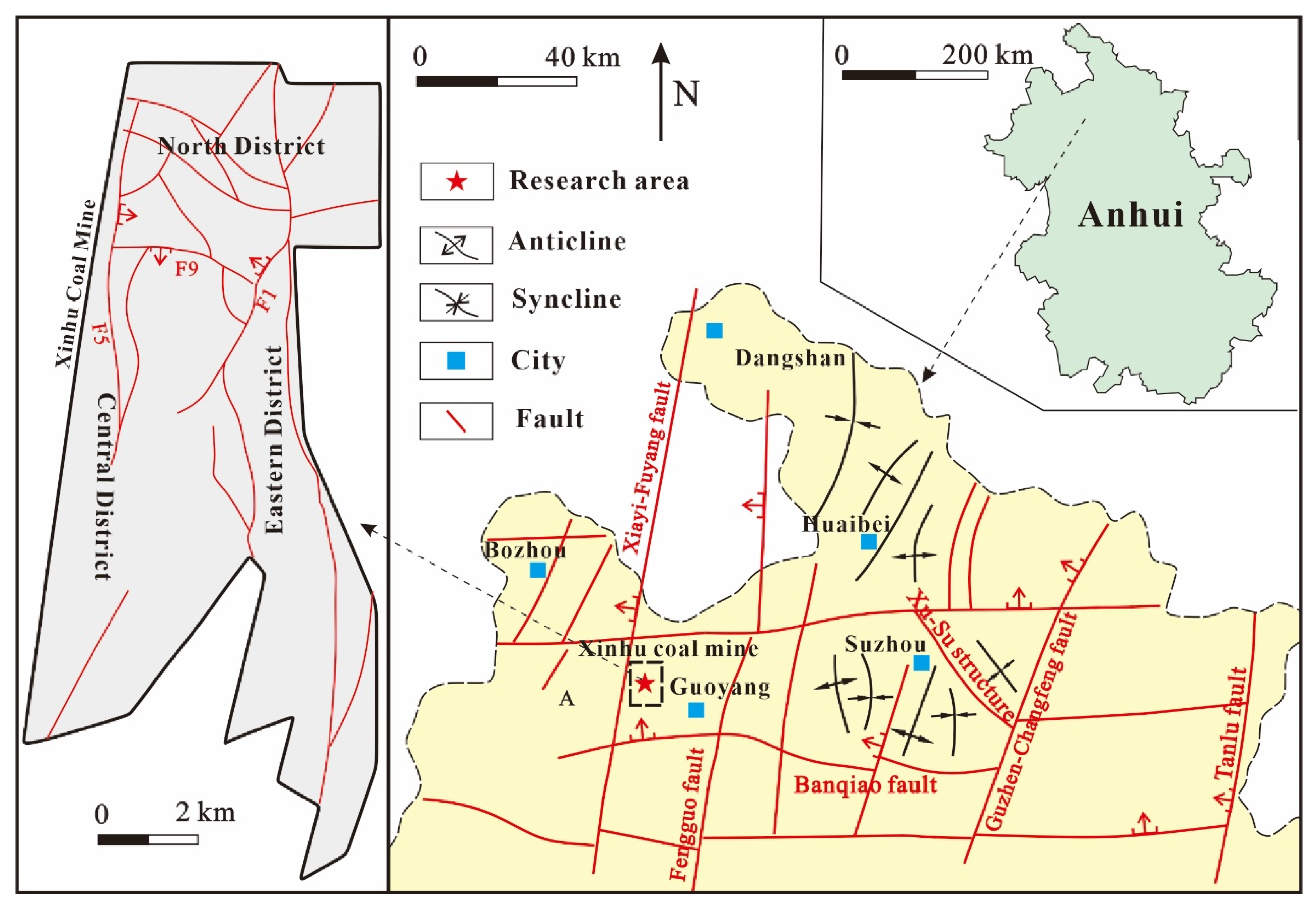
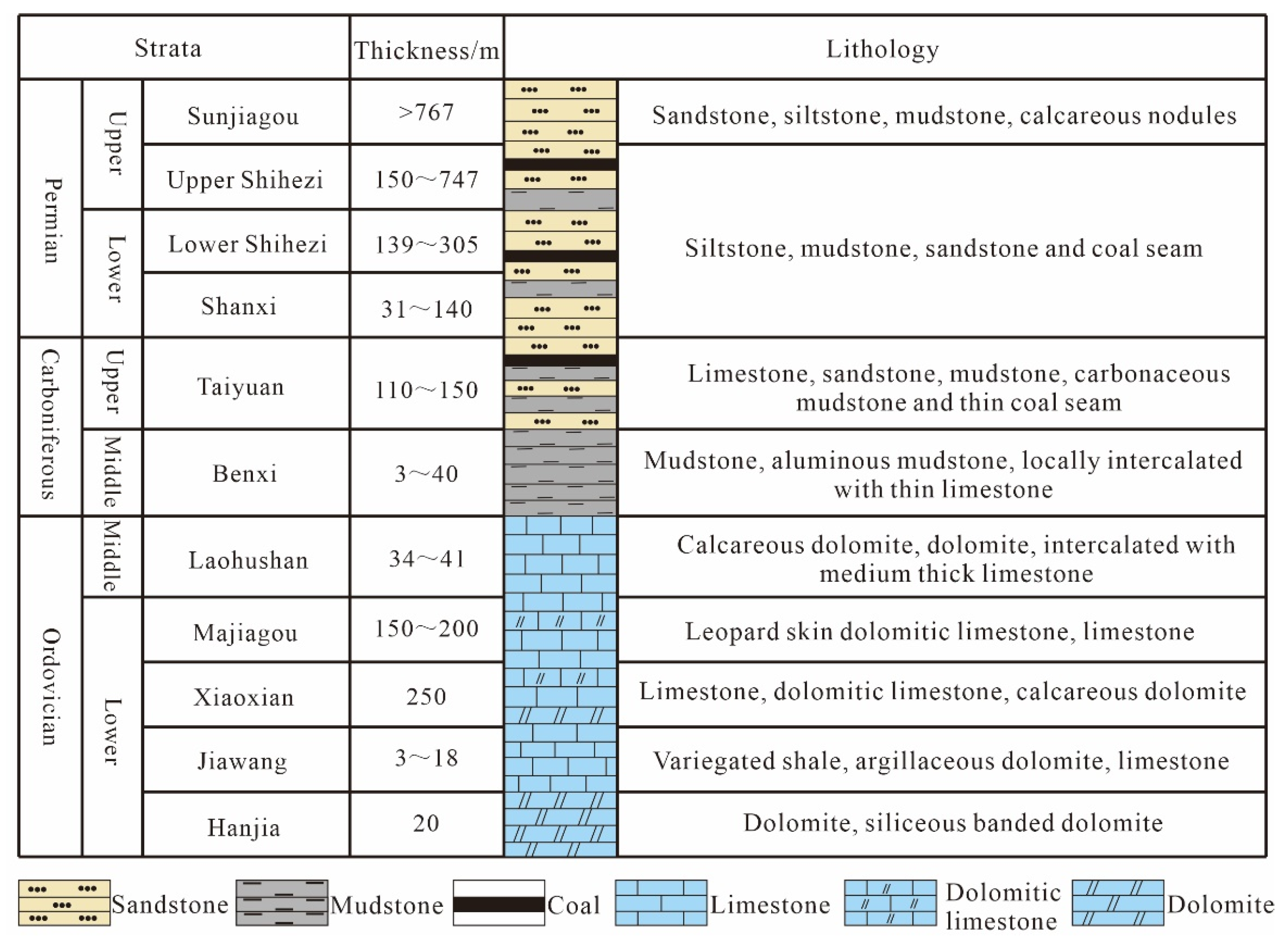

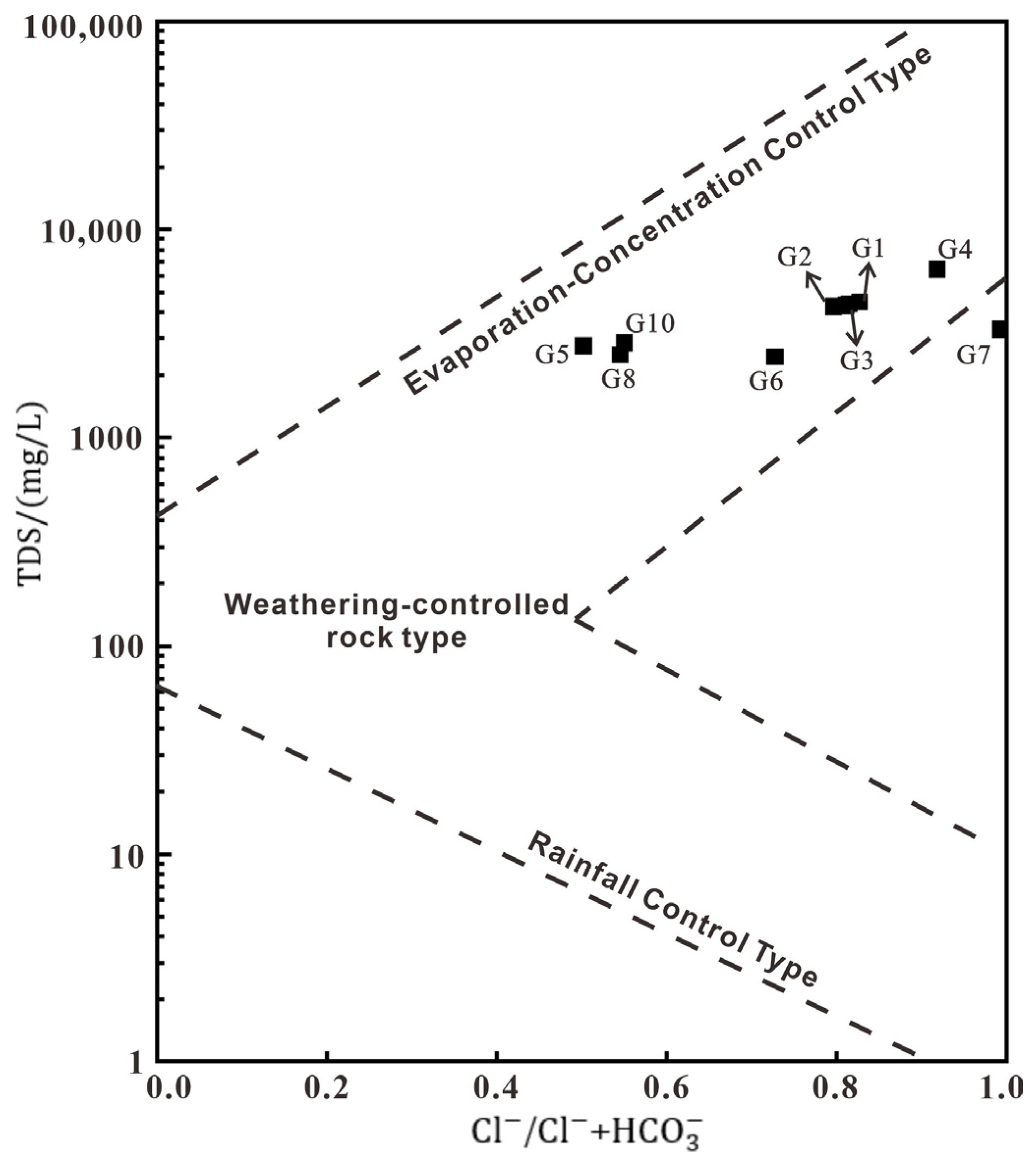
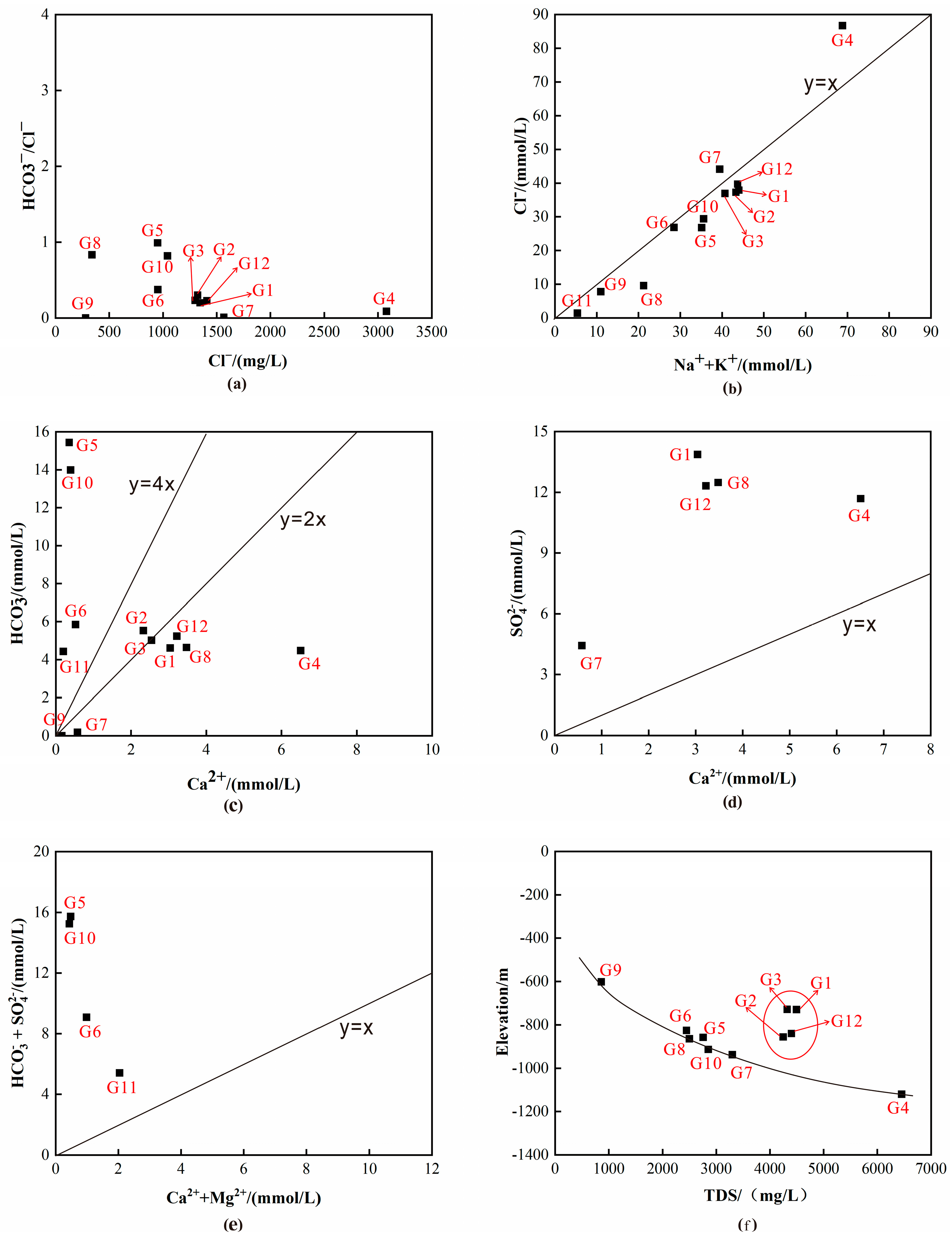
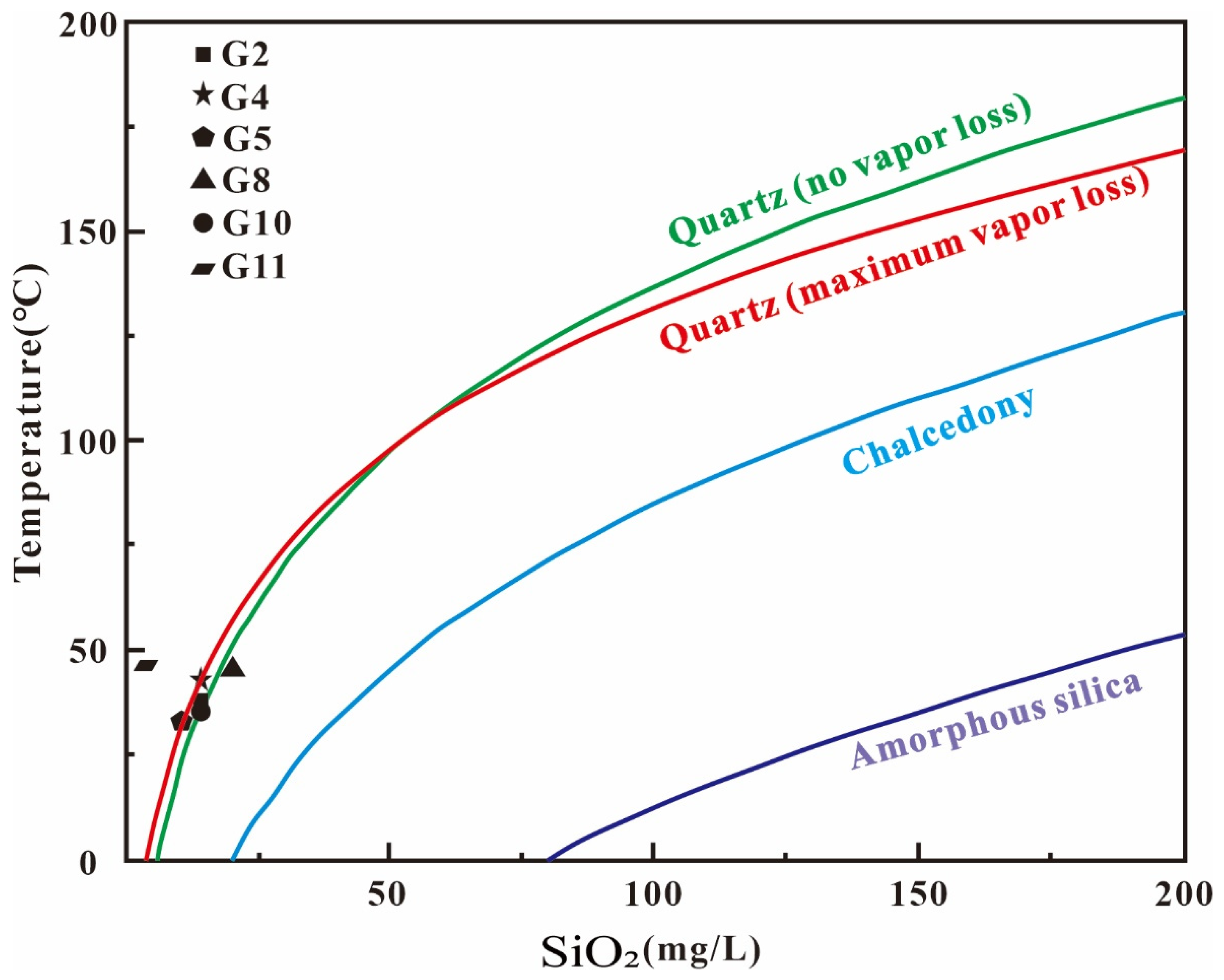

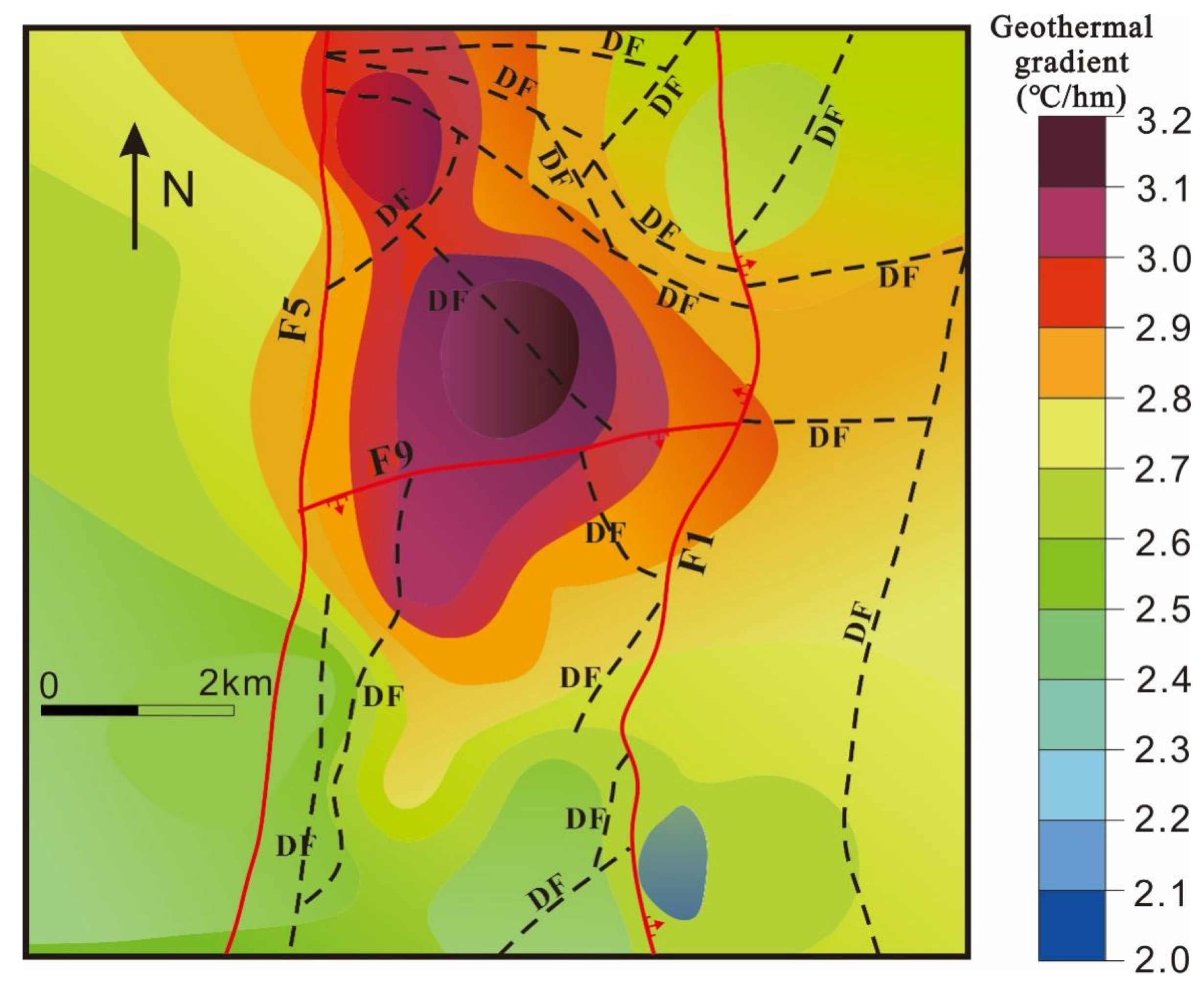

| Sample ID | Depth/m | PH | Total Hardness | Mass Concentration (mg/L) | ||||||||||||
|---|---|---|---|---|---|---|---|---|---|---|---|---|---|---|---|---|
| TDS | ||||||||||||||||
| G1 | 729.2 | 8.06 | 30.487 | 4494 | 1364.43 | 121.83 | 58.33 | 1345.80 | 1331.11 | 281.44 | 0.00 | / | 0.82 | 0.10 | 0.05 | 0.96 |
| G2 | 856.1 | 7.89 | 23.216 | 4245 | 1343.48 | 93.33 | 44.09 | 1322.87 | 1147.54 | 337.73 | 0.00 | 14 | 0.04 | 0.00 | 0.01 | 1.00 |
| G3 | 728.6 | 7.8 | 30.487 | 4320 | 1261.80 | 101.93 | 70.40 | 1310.53 | 1142.60 | 306.35 | 0.00 | / | 0.30 | 0.00 | 0.00 | 0.60 |
| G4 | 1119.8 | 8.4 | 1116.44 | 6452 | 2133.11 | 261.02 | 112.85 | 3078.67 | 1121.61 | 273.37 | 16.81 | 14 | 0.00 | 0.04 | 0.00 | 3.36 |
| G5 | 856.2 | 9.33 | 478.46 | 2757 | 1089.03 | 14.26 | 2.88 | 950.80 | 27.17 | 942.45 | 170.4 | 11 | 0.04 | 0.00 | 0.14 | 3.84 |
| G6 | 825.5 | 8.67 | 5.48 | 2447 | 883.38 | 21.01 | 11.01 | 952.84 | 311.17 | 356.65 | 37.27 | 9 | 0.20 | 0.00 | 0.00 | 1.00 |
| G7 | 961.3 | 10.29 | 74.16 | 3300 | 1222.84 | 23.13 | 3.98 | 1567.02 | 425.59 | 11.45 | 48.98 | 7 | 0.06 | 0.02 | 0.32 | 4.40 |
| G8 | 940.2 | 8.33 | 553.72 | 2500 | 657.78 | 139.39 | 49.95 | 340.04 | 1198.17 | 283.16 | 16.63 | 20 | 0.8 | 0.00 | 0.20 | 0.80 |
| G9 | 601.5 | 12.41 | 23.73 | 860 | 340.00 | 6.34 | 1.92 | 276.53 | 131.71 | 0.00 | 40.65 | / | 0.04 | 0.00 | 0.02 | 2.96 |
| G10 | 886.5 | 8.38 | 43.51 | 2853 | 1103.59 | 15.84 | 0.96 | 1043.24 | 119.78 | 853.70 | 78.98 | 14 | 1.68 | 0.12 | 0.00 | 2.08 |
| G11 | 1258.2 | 9.98 | 201.71 | 630 | 166.77 | 7.92 | 44.18 | 49.52 | 93.84 | 270.48 | 95.61 | 3 | 0.04 | 0.00 | 0.36 | 3.20 |
| G12 | 1031.4 | 8.42 | 30.38 | 4401 | 1355.83 | 128.97 | 53.54 | 1409.35 | 1182.53 | 319.35 | 8.97 | 14 | 0.02 | 0.00 | 1.20 | 1.60 |
Disclaimer/Publisher’s Note: The statements, opinions and data contained in all publications are solely those of the individual author(s) and contributor(s) and not of MDPI and/or the editor(s). MDPI and/or the editor(s) disclaim responsibility for any injury to people or property resulting from any ideas, methods, instructions or products referred to in the content. |
© 2025 by the authors. Licensee MDPI, Basel, Switzerland. This article is an open access article distributed under the terms and conditions of the Creative Commons Attribution (CC BY) license (https://creativecommons.org/licenses/by/4.0/).
Share and Cite
Qin, M.; Zhang, B.; Yu, K.; Zhang, B.; Wang, Z.; Zhu, G.; Zhen, Z.; Sun, Z. Hydrogeochemistry and Heat Accumulation of a Mine Geothermal System Controlled by Extensional Faults. Energies 2025, 18, 2490. https://doi.org/10.3390/en18102490
Qin M, Zhang B, Yu K, Zhang B, Wang Z, Zhu G, Zhen Z, Sun Z. Hydrogeochemistry and Heat Accumulation of a Mine Geothermal System Controlled by Extensional Faults. Energies. 2025; 18(10):2490. https://doi.org/10.3390/en18102490
Chicago/Turabian StyleQin, Mengwei, Bo Zhang, Kun Yu, Baoxin Zhang, Zhuting Wang, Guanyu Zhu, Zheng Zhen, and Zhehan Sun. 2025. "Hydrogeochemistry and Heat Accumulation of a Mine Geothermal System Controlled by Extensional Faults" Energies 18, no. 10: 2490. https://doi.org/10.3390/en18102490
APA StyleQin, M., Zhang, B., Yu, K., Zhang, B., Wang, Z., Zhu, G., Zhen, Z., & Sun, Z. (2025). Hydrogeochemistry and Heat Accumulation of a Mine Geothermal System Controlled by Extensional Faults. Energies, 18(10), 2490. https://doi.org/10.3390/en18102490






